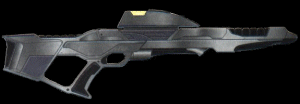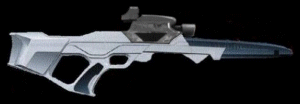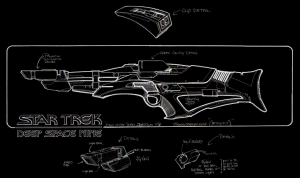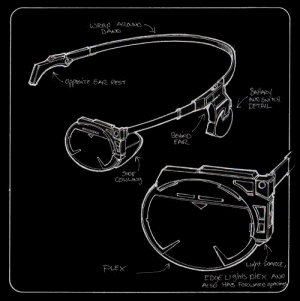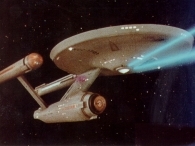|
|

Weapons of The Federation |
| Introduction | |
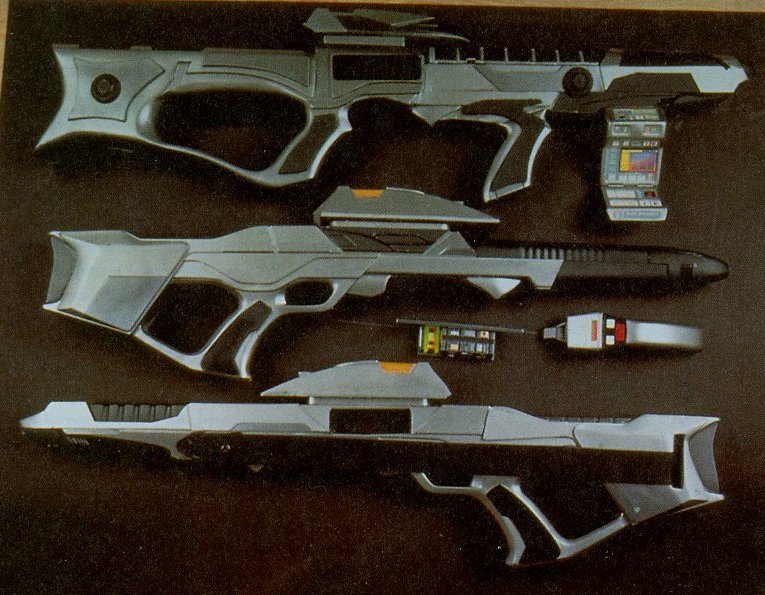 |
Perhaps the most widely-used particle weapon in the Milky Way galaxy, the Phaser (or PHASed Energy Rectification) is an electromagnetic directed-energy weapon. Capable of stunning a humanoid for a few seconds or full-scale vaporization of a target, the Phaser is one of the most powerful weapons available. It should be noted, however, that the Phaser is actually a Disruptor weapon. Phasers, classified as either sidearm or ship borne, currently come in a number of types. Types -1 through -4 are the personal weapon classes, while -5 through -13 are the current classes of ship borne Phaser weapons.
|
| Phaser Operation | |
 |
All
variants of the 23rd century phaser store energy in a sarium
krellide cell. Sarium krellide stores a maximum of
1.3x106 megajoules per cubic centimeter. The power cell is
connected in series to three control modules:
transceiver assembly
(STA):
Energy from the power cell passes through all three modules and is then routed through shielded conduits to the prefire chamber, a sphere of gulium arkenide-reinforced LiCu 521, 1.5 cm in diameter also known as(The Emitter Crystal). This energy is stored temporarily by a charge barrier, which then collapses the energy, discharging it through the emitter crystal as a pulse of energy. The charge barrier collapse takes an average of 0.02 picoseconds, whereupon through a 'rapid nadion' effect the emitter crystal converts the pulse into a tuned phaser discharge. As with a ship's main phaser banks, the greater the energy in the prefire chamber, the higher the percentage of nuclear disruption. Low to moderate phaser settings are calibrated to fall short of this nuclear disruption threshold, limiting the phaser discharge to stun and thermal electromagnetic effects. |
| Types Of Hand Weapons | |
| Phaser Type 1 | |
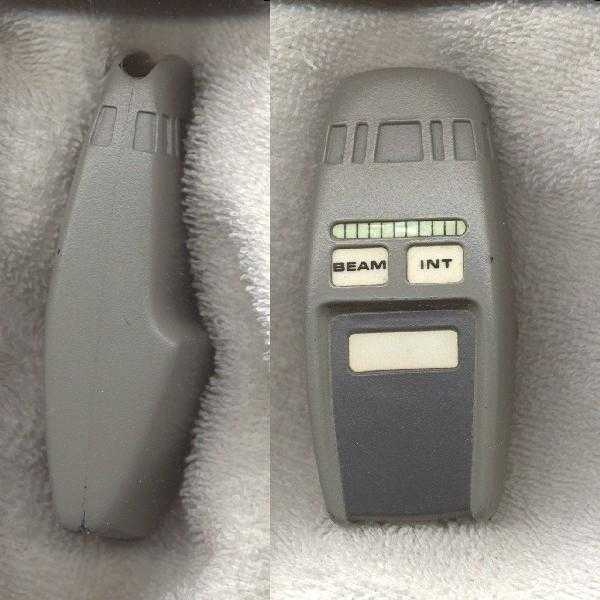 |
Type-1: A small, concealable weapon used when more conspicuous weapons are undesirable, the Type-1 Phaser is often used as a last resort weapon, when a crew member's large and more powerful Type-2 weapon has failed. The Type-1 has three settings (Note: All settings will be compared to the Type-2 weapon): Setting1-Stun: A
medium-power stun setting, will render most humanoids unconscious for
around five minutes.
|
| Type 2 Phaser | |
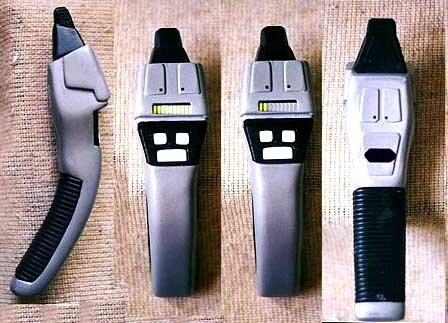 |
Type-2: The
most common type of Phaser in the Federation. Much larger than the Type-1
device, the Type-2 is used more often than any other Phaser weapon aboard
ship or on away missions with the exception of combat scenarios. Often referred to as "pistol" Phasers. The Type-2 has 16 settings:
All Listed Below
|
| Type 3 Weapons | |
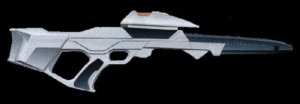
|
Type-3: Introduced into widespread use shortly before the Dominion War (with the introduction of the Sovereign-class starship). Currently, the Type-3 Phaser rifle comes in four variants- Type-3a,
standard Phaser rifle (removed from production in 2371) All Type-3 weapons possess the same 16 settings as the Type-2 variant, with the exception of the -3c and -3d versions. They also possess the settings: 17 - 19
|
| Isomagetic Disintegrator also known as a Type 4 Weapon | |
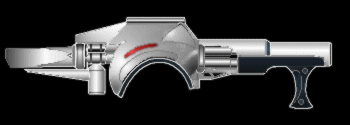 |
Developed in 2410, the Type-4 Phaser provides combat troops with
high-power fire support. This weapon differs from the rifle versions in a
number of ways: it has a much larger power capacity, it can track several
targets at once within a 65 degree arc, and it is much heavier- so much so
that it must be mounted on a shoulder harness, which also carries extra
power supplies, a light shield generator and illumination
beacons.
|
| Compression Phaser Rifle | |
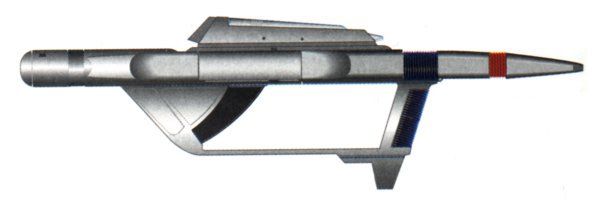 |
A recent
development Weapon, carried on
newer starships such as the USS Voyager. It has an improved
targeting light with grater range, two power clips and a new split emitter
design.
|
| EVA Phaser Rifle | |
 |
Specially designed for use with
environment suits, the EVA rifle has two pistol-grips and no trigger-guard
for ease of handling, as well as magnetized areas for securing in
zero-gravity conditions.
|
| TR-116 Projectile Rifle | |
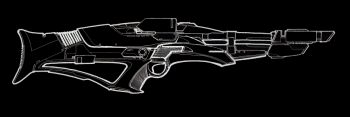
|
An experimental weapon developed by Starfleet Security. It fires tritanium projectiles propelled by expanding gases from a chemical detonation. This rifle was designed for use in areas of high electromagnetic (EM) interference (whether artificial or natural) that would render phasers useless. Access to the replicator pattern for this design is restricted to Starfleet officers only. One unique aspect of the gun is its Exrographic Targeting System, a separate sighting device which communicates with the weapon. The operator wears a wire frame helmet with a monocle attached over one eye, and moves a mouse trackball (mounted on both sides of the weapon, making it ambidextrous) located on the rifle to zoom in to the target. The magazine is contained in the forward handgrip under the barrel, being removed by releasing a catch and sliding it forward. In 2375, one of these rifles was modified on Deep Space Nine with a micro-transporter connected near the barrel exit. The rifle dematerialized the bullet after firing and rematerialized it just in front of the target, and could possibly have done it inside the victim. The person responsible, a traumatized Vulcan officer, murdered several Starfleet personnel before being wounded by another modified TR-116 and taken into custody.
|
| Phaser Settings | |
|
|
The
Settings Below apply to the Type 2 Phaser and Above.
These settings are as listed in the Next Generation Technical Manual |
| Setting:
1 Description: Light Stun | |
|
Discharge Energy
Index: 15.75
*A standardized damage index is derived for setting comparisons; each whole number represents the number of centimeters of material penetrated or damaged at the molecular level. | |
| Setting:
2 Description: Medium Stun | |
|
Discharge Energy
Index: 45.30
| |
| Setting:
3 Description: Heavy Stun | |
|
Discharge Energy
Index: 160.65
| |
| Setting:
4 Description: Low Thermal Effects | |
|
Discharge Energy
Index: 515.75
| |
| Setting:
5 Description: High Thermal Effects | |
|
Discharge Energy
Index: 857.5
| |
| Setting:
6 Description: Light Disruption Effects | |
|
Discharge Energy
Index: 2700
| |
| Setting:
7 Description: Moderate Disruption Effects | |
|
Discharge Energy
Index: 4900
| |
| Setting:
8 Description: Medium Disruption Effects | |
|
Discharge Energy
Index: 15000
| |
| Setting: 9 Description: High Disruption Effects | |
|
Discharge Energy
Index: 65000
| |
| Setting: 10 Description: Extreme Disruption Effects | |
|
Discharge Energy
Index: 125000
| |
| Setting: 11 Description: Slight Explosive/Disruption Effects | |
|
Discharge Energy
Index: 300000
| |
| Setting: 12 Description: Light Explosive/Disruption Effects | |
|
Discharge Energy
Index: 540000
| |
| Setting: 13 Description: Moderate Explosive/Disruption Effects | |
|
Discharge Energy
Index: 720000
| |
| Setting: 14 Description: Medium Explosive/Disruption Effects | |
|
Discharge Energy
Index: 930000
| |
| Setting: 15 Description: High Explosive/Disruption Effects | |
|
Discharge Energy
Index: 1.17 x 106
| |
| Setting: 16 Description: Extreme Explosive/Disruption Effects | |
|
Discharge Energy
Index: 1.55 x 106
| |
|
Setting: 17 Description: For Type 3 Weapons only | |
| A high-power disruption setting, will cause minor geological displacement. | |
|
Setting: 18 Description: For Type 3 Weapons only | |
| A high-power disruption setting, will cause moderate geological displacement. Melting of starship-grade armor occurs after prolonged firing. | |
|
Setting: 19 Description: For Type 3 Weapons only | |
| A high-power disruption setting, will cause moderate geological displacement. Completely negates personal and light vehicle shielding and armor. | |
| Ship borne Phasers | |
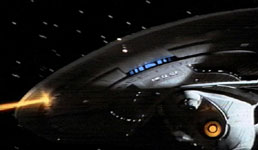
|
Starship Phasers, as would be expected, are of much greater power than any personal weapons. Most Phasers have an effective range of around 300,000 km (around one light-second), but some, most noteably the new Type-12a and -13 Phasers have an increased range closer to 400,000 km. Pulse Phasers, due to the increased energy in the actual packet, do not possess enough kinetic energy to reach these distances, and typically have an effective range of around half standard phasers. Thanks to today's superior fire-control computers, Starship Captains have a much greater degree of control over their Phasers- in both precision targeting and power levels. A Starship Phaser, if it could power down low enough, could easily discharge enough energy to render a 35 year-old human man weighing 120 kg unconscious for exactly two minutes. However, due to the massive energy levels involved, ship borne Phasers cannot power down to such a low level. The accuracy remains, however. Between the first ship borne Phaser, the Type-5, and today's latest model, the Type-13, the only real difference is in power and range. While Type-5 weapons functioned only at around 165,000 km, the latest Type-13 weapons have an effective reach of over 400,000 km.
|
| Sub-section 1:Meson Phasers | |
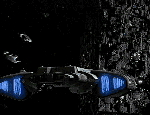 |
Meson Phasers are Phasers of greatly increased power. Meson units saw action from their introduction until 2413, when production of starships large enough to accomodate them slowed in order to revert the trend of "bigger is better". Mesons (in certain forms) are weakly interacting particles with short, but predictable, lifespans. While they exist, mesons behave in a manner indistinguishable from neutrinos, and pass through matter unimpeded. At the end of the meson's life it decays, releasing photons. If the meson is of high enough energy, these will be in the form of gamma rays. A Meson's lifespan can be controlled by it's velocity - the higher the apparent velocity, the longer the apparent lifespan. As a result of this, a meson accelerator can be used to place a gamma-ray burst at a percise location by controlling the velocity of the beam. Since mesons can be weakly interacting, a meson beam could be fired through a target's shields without being impeded - effectively ignoring them. Mesons have a lifespan of only a few hundred milliseconds, giving a meson battery a similar range to a conventional phaser array. Also, since targets can rarely be located exactly in space, and in any case the beam's "focus" would not be percise, a proportion of the beams energy (perhaps as much as 2/3rds) would be wasted as mesons decayed outside the target's shields. A decaying meson beam (i.e. one near it's target) would be easily detected by observers, since the photons are emitted in random directions from a decaying Meson. Lastly, the apparatus to generate a Meson beam of a given power output is much bulkier then a phaser array. |







